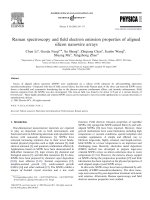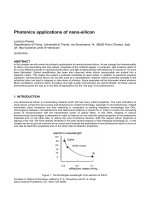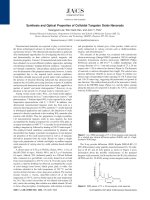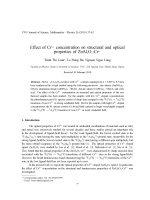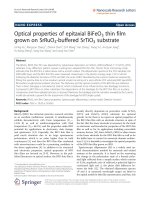- Trang chủ >>
- Khoa Học Tự Nhiên >>
- Vật lý
Tripathy, optical properties of nano silicon
Bạn đang xem bản rút gọn của tài liệu. Xem và tải ngay bản đầy đủ của tài liệu tại đây (84.78 KB, 5 trang )
Bull. Mater. Sci., Vol. 24, No. 3, June 2001, pp. 285–289. © Indian Academy of Sciences.
285
Optical properties of nano-silicon
S TRIPATHY, R K SONI*, S K GHOSHAL and K P JAIN
Department of Physics, Indian Institute of Technology, New Delhi 110 016, India
Abstract. We investigated the optical properties of silicon clusters and Si nanocrystallites using photolumine-
scence (PL) and Raman scattering technique. Broad luminescence band in the red region was observed from
Si-doped SiO
2
thin films deposited by co-sputtering of Si and SiO
2
on p-type Si (100) substrates, annealed in Ar
and O
2
atmosphere. Nanocrystalline Si particles fabricated by pulsed plasma processing technique showed
infrared luminescence from as grown film at room temperature. Raman spectra from these films consisted of
broad band superimposed on a sharp line near 516 cm
–1
whose intensity, frequency, and width depend on the
particle sizes arising from the phonon confinement in the nanocrystalline silicon. We also performed PL,
Raman and resonantly excited PL measurements on porous silicon film to compare the optical properties of Si
nanostructures grown by different techniques. An extensive computer simulation using empirical pseudo-
potential method was carried out for 5–18 atoms Si clusters and the calculated gap energies were close to our
PL data.
Keywords. Nanocrystalline silicon; Raman scattering; photoluminescence; porous silicon.
1. Introduction
Desire for the integration of silicon nanostructures in
optical devices has led to the search for silicon-based
materials and structures that emit light with high quantum
efficiency. Recently, the discovery of luminescence from
Si nanostructures by Canham (1990) has attracted much
attention towards the quantum mechanical nature of this
phenomenon. The optical and electronic properties of the
materials are not yet fully understood. Surface effects
(large surface to volume ratio) as well as quantum con-
finement effects are considerably enhanced in silicon
nanostructures which control the photoluminescence. Sili-
con quantum dots have attracted intense theoretical and
experimental investigations in recent years. The impor-
tance of such an investigation stems from the fact that the
modeling of such novel materials requires a fundamental
understanding of the electronic structure including the
role played by surface having different geometry, dis-
order, inhomogeneity and so on. Thus, inspite of intensive
studies by Kanemitsu (1995) and John and Singh (1995),
no conclusive argument has been given on the mecha-
nisms of efficient light emission from porous silicon and
related materials. In porous silicon the luminescence
properties may be related to different silicon compounds
such as a-Si : H, polysilane, SiH
x
and surface defect
states. One of the explanations given by Takagahara and
Takeda (1996), for the blue-shifted photoluminescence
from porous silicon is that the microstructure consists of
islands of isolated quantum dots, each experiencing quantum
confinement. Experimental efforts to create silicon-based
light-emitting films have been made applying various tech-
niques such as sputtering, plasma processing and anodic
etching. Morisaki et al (1991) reported the visible light
luminescence from some other form of Si nanostructures
such as Si ultrafine particles deposited by evaporation of
silicon powders in an Ar atmosphere. Visible lumine-
scence from Si ultrafine particles embedded in SiO
2
was
also reported by Osaka et al (1992). Since the silicon sur-
face in the Si-doped SiO
2
is protected from contamination
and natural oxidation in air, it is expected to show more
stable luminescence than other Si nanostructures.
In this report we studied luminescence mechanism in
the Si-doped SiO
2
thin films prepared by RF sputtering of
a target consisting of Si pieces placed on a SiO
2
substrate
in Ar and O
2
atmosphere. Raman scattering and PL studies
were also performed on nanocrystalline silicon prepared
by pulsed plasma processing. For comparative study,
Raman and PL measurements were performed on porous
silicon prepared by simple anodic etching technique. In
order to explain the luminescence results, we have used
the empirical pseudopotential method to calculate the ele-
ctronic structure of Si quantum dots of different sizes. We
found an enhancement of the calculated gap energy when
the surface of the dot was passivated with the hydrogen
atoms incorporating proper hydrogen pseudopotential.
2. Experimental
PL measurements were performed on the Si-doped SiO
2
thin films deposited on p-type Si (100) substrates by
*Author for correspondence
†
Paper presented at the 5th IUMRS ICA98, October 1998,
Bangalore
S Tripathy et al
286
co-sputtering of Si and SiO
2
. The sputtering targets were
16 and 36 Si pieces (5 mm × 5 mm) placed on SiO
2
sub-
strates to vary the compositional fraction of Si/SiO
2
in the
samples. The samples were annealed in Ar and O
2
atmos-
phere at temperatures ranging from 300 to 1100°C. PL
and Raman measurements were also performed on spheri-
cal shaped nanocrystalline Si clusters less than 10 nm,
grown by pulsed gas supply of SiH
4
and H
2
in very high
frequency (VHF) plasma. Porous silicon was grown in the
dark on a (100) oriented p-Si wafer with resistivity
8 Ω cm, by anodic etching in a HF solution for 30 min
etch time at a current density of 10 mA/cm
2
. PL and
Raman scattering were excited in these nanometer sized
silicon particles using Ar
+
laser and the signal was dis-
persed using a double monochromator. Conventional
photon counting electronics was used to record the spectra.
Resonantly excited PL spectra were taken using 647 nm
line of Kr
+
laser where the incident laser power was kept
below 20 mW.
3. Results and discussion
Figure 1 shows PL spectra of Si-doped SiO
2
thin films
annealed in O
2
and Ar atmosphere with 16 and 36 piece
silicon targets. Broad luminescence band in the red region
was observed in the annealed samples. The emission band
resembles that of porous silicon. The peak positions vary
with annealing condition for the same Si/SiO
2
composi-
tions. It shows PL emission process occurring at higher
wavelengths for sample annealed under Ar, than those
annealed under O
2
atmosphere, when annealing tempera-
ture was increased. We believe that the luminescence does
not reflect the band-to-band transitions and involves
radiative recombination via recombination centres. As the
radiative recombination centres may be associated with
the surface states in the nanocrystalline silicon, the PL
peak energy will be smaller than the band gap of a Si
nanocrystal. The large broadening in the PL spectra can
be associated with a large distribution of particle size in
the grown film. The PL of the dot ensemble is due to the
fluctuation in dot size, shape and strain corresponding to
the statistical distribution of the eigen energies. Conside-
ring PL gap energy varying as 1/d
2
, where ‘d’ is size of
the nanocrystallite, the particle sizes are estimated to be
3⋅5 nm to 4⋅5 nm in these samples using first principle
calculation. The particle sizes are smaller for the samples
annealed in O
2
prepared by 16 piece silicon targets.
Figure 2 shows PL spectra from Si nanocrystallites
grown by pulsed plasma technique on quartz substrates.
The infrared PL is observed from the as grown film at
room temperature. The fine silicon particles (4–10 nm
size) grown under this condition shows good control on
particle size distribution. Infrared absorption measure-
ments have clarified that the surface of these nanocrysta-
lline silicon particles is covered by hydrogen. Experi-
mentally it has been found that the crystalline size
increases with increasing the hydrogen plasma treatment
Figure 1.
PL spectra of Si-doped SiO
2
thin films under
different preparation conditions. (a
) 36 pieces of Si targets
annealed in Ar, (b) 36 pieces of Si targets annealed in O
2
, (c) 16
pieces of Si target annealed in Ar and (d) 16 pieces of Si targets
annealed in O
2
.
Figure 2.
Room temperature Raman spectra of (a) nano-
crystalline Si prepared by pulsed plasma process
ing and
(b) porous silicon prepared by anodic etching using 488
nm line
of Ar
+
laser.
Optical properties of nano-silicon
287
time or with decreasing the thickness of the a-Si : H layer.
This results in termination of dangling bonds of the sur-
face Si atoms of nanocrystalline silicon. Nanocrystalline
silicon thus fabricated is embedded in an a-Si : H matrix.
We have studied the phonon states in these nanocrysta-
lline silicon using Raman scattering. The Raman spectra
shown in figure 3 from this sample consists of a broad
band superimposed on a sharp line near 516 cm
–1
. We
argue that the sharp line, whose intensity, frequency, and
width depend on the particle size, arises from the phonon
confinement in nanometer sized crystalline silicon. The
broad Raman band resembles that of density-of-state
spectrum in amorphous silicon and indicates the presence
of amorphous silicon like structure in the film. The dis-
order in the surface layer of the silicon particles is attri-
buted to the amorphous structure. For comparative study,
the PL and Raman spectra from porous silicon film is also
shown in figures 2 and 3. The size dependence of the
Raman spectra is analyzed using spatial correlation model
which takes into account the discrete wave vector of the
confined phonon. The peak position of the strong Raman
line at 514 cm
–1
observed in the case of porous silicon
layer undergoes very small changes as compared to those
of crystalline silicon. The asymmetrically broadened line
shape was studied using a model of phonon confinement
proposed by Campbell and Fauchet (1986) which suggests
that local structure of porous silicon is more likely a sphere
than a rod and has a characteristic diameter 3⋅5–5⋅5 nm.
The photo-excited light emission in porous silicon is
characterized by a broad band in the visible region as
evident from PL spectra excited with 488 nm (2⋅54 eV)
laser line. The higher energy excitation leads to convolu-
tion of large quantized bands (more discrete states) in the
conduction band giving rise to multiple broad peaks in the
PL spectrum, which is also attributed to highly disordered
local structure. It has been proposed that shift of the lumi-
nescence from infrared to visible region of porous silicon
is caused by the band gap widening resulting from the
quantum size effects. Whether the porous silicon skeleton
basically consists of Si wires or nanoparticles or even a
combination of both, we believe that the steady state PL at
room temperature is also controlled by the radiative
recombination of carriers in the surface-localized states.
The radiative recombination of the localized electrons
trapped by the surface states located within the band gap
of porous silicon with its partner in the valence band and
the radiative recombination of photon-excited electron-
hole pairs trapped in the crystalline nanostructures as
Figure 4. Resonantly excited PL spectra from porous silicon
using 647 nm line of Kr
+
laser at (a) 30 K and (b) 80
K. Step
onset phonon energy separations are estimated from the model
proposed by Suemoto et al (1993).
Figure 3. PL spectra of (a) nanocrystalline silicon and
(b) porous silicon. The multiple peak PL spectrum in porous
silicon is fitted with combi
nation of three Gaussian distribution
functions.
S Tripathy et al
288
excitons, resulted into multiple luminescence peaks. To
further explain the PL mechanism resonant excitation was
performed using 1⋅916 eV line of Kr
+
laser. Figure 4
shows resonantly excited PL spectra with step like phonon
structures (energy difference 56 ± 2 meV between each
step) at two different temperatures. At different tempera-
tures the onset shows broadening and we found an
increase in the onset energies of the phonons towards
lower side with increasing temperature. The quantitative
explanation of this phonon structure was given by
Suemoto et al (1993). In this resonant excitation, the PL
spectrum results from the superposition of the emission
lines of all the quantum particles excited with different
efficiencies. A quantitative evaluation of these onset
energies suggests that their source has a phonon spectrum
and the optical selection rules are similar to that of crysta-
lline silicon. The onsets in our resonantly excited PL
spectra are due to the optical transitions involving the
emission of 0, 1, and 2 TO(∆) momentum-conserving
phonons with weak features associated with weakly
coupled TA(∆) phonons. Our experimental results des-
cribe the two luminescent material model by Rosenbauer
et al (1995), where PL originates from quantum-confined
crystalline Si with resonant excitation at 647 nm and from
unspecified additional luminescent material with excita-
tion in the range 514–488 nm. As all the experimental
aspects of the phonon structures and PL mechanism can-
not be explained consistently with a specified model,
more elaborate experimental and theoretical analysis are
needed to confirm the luminescence in Si nanostructures
and porous silicon. In order to explain the PL mechanism
in the Si nanostructures due to quantum confinement in
the near surface region, we calculate the band gap that is
sensitive to the surface effects and the shape of the silicon
quantum dots. The theoretical calculations are based on
the empirical pseudopotential method (EPM) for the
electronic structure of silicon quantum dots of different
sizes. Following the model of Wang and Zunger (1994),
we use the local pseudopotential of the form
1
)(
2
4
3
2
2
1
Si
−
−
=
qa
ea
aqa
V
,
with a
1
= 0⋅2685, a
2
= 2⋅19, a
3
= 2⋅06, and a
4
= 0⋅487 in
the atomic units (Hartree for energy, Bohr
–1
for momen-
tum, q). The hydrogen empirical pseudopotential (in
atomic units) is given by
V
H
(q) = – 0⋅1416 + 0⋅009802q + 0⋅06231q
2
– 0⋅01895q
3
; when q ≤ 2,
;
02219692038770028980
)(
432
H
qqq
q
qV
⋅
−
⋅
+
⋅
−
⋅
+=
when q > 2.
We used an ideal unrelaxed structure with Si–H bond
distance of 1⋅487 Å for all the cases. We expand the dot
wavefunctions in a large basis of plane waves as
ψ
j
(r) = Σ
G
B
j
(G)e
iG⋅r
,
where, G is a reciprocal vector and B
j
(G) are the expan-
sion coefficients. To find the size dependence of the gap
energy and the near band gap solutions i.e. the separation
between the highest occupied molecular orbital (HOMO)
and the lowest unoccupied molecular orbital (LUMO), we
solve the effective single-particle Schrödinger equation
for different sizes of the quantum dot. We use a cut off
energy of 5R
y
for the plane wave expansion and a silicon
bulk lattice constant of 5⋅43 Å for the smallest dot. We
find all eigenvalues by direct diagonalization method. The
transformation between ψ
j
(r) on a real space grid and
B
j
(G) on a reciprocal space grid is done by numerical fast
Fourier transform (FFT). The numerical results for the
four different sizes and geometries of the clusters are
given in table 1. The value of the gap energy decreases as
the size of the cluster increases, which implies a weaker
Table 1.
Calculated gap energy of Si clusters with different sizes (with and without hydrogen at the surface).
Number of
atoms in Si
cluster
Arrangement of Si atoms
Fixed bond length
of Si atoms
(Å)
Gap energy
without H
(eV)
Gap energy
with H
(eV)
5 Five atoms in tetrahedral arrangements 5⋅43 1⋅997 2⋅07
8
Eight atoms joined by single bond with an
appropriate dihedral angle
4⋅00 1⋅820 1⋅89
17 Seventeen atoms cluster with four tetra-
hedrally arranged nearest neighbours and
twelve neighbours at fcc centres
3⋅20 1⋅790 1⋅85
18 Eighteen atom
s cluster using a cubic cell
with eight corner atoms, six face centred
atoms and four from other sub-
lattice entirely
included in it
3⋅00 1⋅690 1⋅82
Optical properties of nano-silicon
289
confinement for large sizes. As we saturate the surface
with hydrogen atoms, there is an enhancement of gap
energy in the range 0⋅08–0⋅13 eV as we go from 5 to 18
atoms cluster. The variation of gap energy for different
sizes of the dot with and without hydrogen passivated
surfaces is shown in figure 5. Here we have calculated the
effective size of the dot under linear mapping d = Na (Å)
only to get a proper scaling of our data points. We find
the gap energy increases as the size of the dot decreases,
which confirms the stronger confinement for the smaller
sizes. The higher value of the gap energy in the presence
of hydrogen is due to strong Si : H bonds which has a
confinement effect in the near surface region.
The electronic states in Si cluster can be classified into
three categories: (i) delocalized states that experience full
confinement effect, (ii) strongly localized states with
spatial distribution smaller than the cluster diameter.
Their energy lies deep into the gap and are insensitive to
the confinement effect thus exhibit no blue shift, and
(iii) weakly localized states with spatial distribution of the
order of the cluster diameter with energy near the gap and
show intermediate blue shift. The apparent blue shift in
amorphous silicon clusters thus has two origins (i) the
varying proportion of clusters on strongly localized states
and (ii) the usual confinement effect on the other states.
Delerue et al (1999) obtained a two-peak density of state
distribution corresponding to strongly and weakly loca-
lized or delocalized states in larger amorphous Si clusters.
In hydrogenated clusters they show only the normal confine-
ment effect and HOMO–LUMO gap values closer to the
c-Si clusters. Similar results have also been obtained by
Allan et al (1997) for the average HOMO–LUMO gap vs
size for layers. It must be emphasized that the experimen-
tal results do not critically depend on the presence of
hydrogen in the layer while theoretical calculations show
clear distinction between hydrogen free and hydrogenated
clusters.
4. Conclusions
The optical properties of Si nanocrystallites and Si clus-
ters prepared by different techniques were investigated
using PL and Raman scattering. The PL shows broad
luminescence band in the red region from Si-doped SiO
2
thin films prepared by co-sputtering of Si and SiO
2
,
annealed in Ar and O
2
atmosphere. The nanocrystalline
silicon particles prepared by pulsed plasma technique
shows infrared PL band. The Raman spectra from this
sample show a broad band superimposed on a sharp line
and is associated with amorphous silicon like structure in
the film. Similar investigations in porous silicon were
done to correlate the optical properties of Si nanostruc-
tures prepared by different techniques. The resonantly
excited PL spectra shows step-like phonon structures,
which corresponds to different luminescence mechanism
in porous silicon. In order to explain the luminescence
results, electronic structure of 5–18 atoms Si quantum
dots is calculated using empirical pseudopotential
method. The calculated gap energy is enhanced when the
dot is passivated with hydrogen atoms incorporating
proper hydrogen pseudopotential.
Acknowledgements
We would like to thank Prof. S Nozaki, University of
Electrocommunications, Japan and Prof. S Oda, Tokyo
Institute of Technology, Japan for providing Si-doped
SiO
2
thin film and nanocrystalline Si samples.
References
Allan G, Delerue C and Lannoo M 1997 Appl. Phys. Lett. 71
1189
Canham L T 1990 Appl. Phys. Lett. 57 1046
Campbell I H and Fauchet P M 1986 Solid State Commun. 58
739
Delerue C, Allan G and Lannoo M 1999 J. Lumin. 80 65
John G C and Singh V A 1995 Phys. Rep. 263 93
Kanemitsu Y 1995 Phys. Rep. 263 1
Morisaki H, Ping F W, Ono H and Yazawa K 1991 J. Appl.
Phys. 70 1869
Osaka Y, Tsunetomo K, Toyomura F, Myoren H and Kohno K
1992 Jpn J. Appl. Phys. 31 L365
Rosenbauer M, Finkbeiner S, Bastarret E, Weber J and Stutz-
mann M 1995 Phys. Rev. B51 10539
Suemoto T, Tanaka K, Nakajima A and Itakura T 1993 Phys.
Rev. Lett. 70 3659
Takagahara T and Takeda K 1996 Phys. Rev. B53 R4205
Wang L W and Zunger A 1994 J. Chem. Phys. 100 2394
Figure 5. Plots of gap energy as a function of number of Si
atoms and effective size of the cluster. The open and closed
squares represent the gap energy of Si dots with and without
hydrogen atoms.

